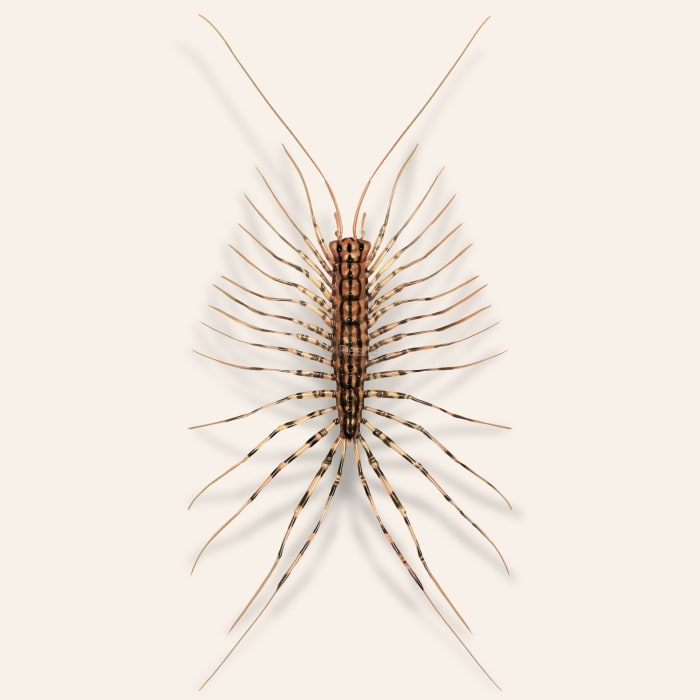How to identify and get rid of house centipedes

House centipedes: harmless roommates or cause for concern?
There’s something about a critter with lots of long legs that gives many people the shivers. Centipedes are no exception. Couple that with the fact that they can scurry quickly and unexpectedly across your floor, and you can understand why people wouldn’t want house centipedes in their homes.
House centipedes are a common centipede that often wanders into many homes across the US and the world. They are quite sensitive to sunlight so when one’s hiding place is uncovered, they dart away to find their next home for the day.
However, centipedes aren’t necessarily trying to take over your space when you find them in your home. They might be just looking for a snack on their way through the bathroom, kitchen, or garage.
How to identify house centipedes
House centipedes can be quickly identified by their many long legs. While the name centipede might mean 100 legs, house centipedes don’t even come close to half that. They have 15 pairs of legs and a long pair of antennae that they use to smell and feel for food.
Additionally, they will typically have black stripes on their body and bands on their legs.
How big are house centipedes?
While the body is only 1-1.4 inches long, the antennae and legs make it seem much bigger. Some house centipedes can be 3-4 inches long from end to end.
What other pests look like a house centipede?
There aren’t very many pests that look like a house centipede, although, at first glance, earwigs, garden millipedes and silverfish might look like them. However, those long, banded legs on the house centipedes are a dead giveaway!
Where do house centipedes live?
Their preferred habitat is away from sunlight and in a dark and moist area with lots of insects to eat. That can include places in your yard, like under rocks, in wood piles, under leaves, or in compost piles.
In your home, you’ll probably find house centipedes in cool, damp places like your basement, garage, or even the bathroom.
How to get rid of house centipedes
House centipedes come into a home or property for three things: food, shelter, and moisture. By eliminating these, you can greatly reduce the number of centipedes that stumble into your home.
House centipedes are active hunters, preying on spiders and common household insects, including pests like cockroaches, bed bugs, termites, silverfish, and ants. If you notice many centipedes in your home, you might have an underlying issue to take care of first.
Create an insect barrier around the property, like Pestie’s DIY solution. You’ll get pro-grade solutions that are customized to your home.
Or, instead of trying to kill the centipede, since it practically does your pest control for you, you could remove it from your home unharmed and release it outside. Vacuuming them or sweeping them up helps too.
Treat house centipedes with Pestie
If you're still having trouble keeping house centipedes away, the best option is to use a pro-grade, effective pest control solution like Pestie.
Pestie is a do-it-yourself pest control solution that's specially designed to keep house centipedes and other pests away from your home.
With Pestie, you can rest easy knowing that your living space is protected and free of creepy crawlies. And the best part? It's designed for people, pets, and the planet, so you can say goodbye to harsh chemicals and hello to peace of mind!
- Save hundreds compared to traditional annual pest plans
- People, pet, and planet-friendly
- Pro-grade customized formulas
Quick facts
- Scientific name
Scutigera Coleoptrata
- Other common names
Thousand Leggers
- Colors
Yellowish-grey with black stripes and banded legs
- Life span
Up to ten years
- Diet
Insectivore (meaning it eats spiders, bed bugs, termites, cockroaches, silverfish, and ants
How dangerous are House Centipedes?
Low danger risk
House centipedes aren’t dangerous to humans and aren’t aggressive either. They will usually try to run away rather than bite or sting. House centipedes have two appendages on either side of their head that act like venomous stingers, called forcipules. This is how they kill their prey.
But, these forcipules aren’t strong enough to sting or pierce your skin. If they do manage to sting you, it feels like a weak bee sting. Bites or stings are very rare.
Centipedes are very fast and can run up to 1.3 feet per second!








